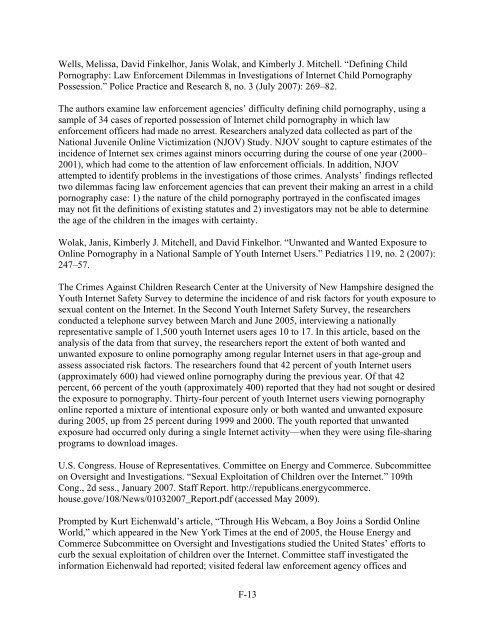The National Strategy for Child Exploitation Prevention and Interdiction
The National Strategy for Child Exploitation Prevention and Interdiction
The National Strategy for Child Exploitation Prevention and Interdiction
You also want an ePaper? Increase the reach of your titles
YUMPU automatically turns print PDFs into web optimized ePapers that Google loves.
Wells, Melissa, David Finkelhor, Janis Wolak, <strong>and</strong> Kimberly J. Mitchell. “Defining <strong>Child</strong>Pornography: Law En<strong>for</strong>cement Dilemmas in Investigations of Internet <strong>Child</strong> PornographyPossession.” Police Practice <strong>and</strong> Research 8, no. 3 (July 2007): 269–82.<strong>The</strong> authors examine law en<strong>for</strong>cement agencies’ difficulty defining child pornography, using asample of 34 cases of reported possession of Internet child pornography in which lawen<strong>for</strong>cement officers had made no arrest. Researchers analyzed data collected as part of the<strong>National</strong> Juvenile Online Victimization (NJOV) Study. NJOV sought to capture estimates of theincidence of Internet sex crimes against minors occurring during the course of one year (2000–2001), which had come to the attention of law en<strong>for</strong>cement officials. In addition, NJOVattempted to identify problems in the investigations of those crimes. Analysts’ findings reflectedtwo dilemmas facing law en<strong>for</strong>cement agencies that can prevent their making an arrest in a childpornography case: 1) the nature of the child pornography portrayed in the confiscated imagesmay not fit the definitions of existing statutes <strong>and</strong> 2) investigators may not be able to determinethe age of the children in the images with certainty.Wolak, Janis, Kimberly J. Mitchell, <strong>and</strong> David Finkelhor. “Unwanted <strong>and</strong> Wanted Exposure toOnline Pornography in a <strong>National</strong> Sample of Youth Internet Users.” Pediatrics 119, no. 2 (2007):247–57.<strong>The</strong> Crimes Against <strong>Child</strong>ren Research Center at the University of New Hampshire designed theYouth Internet Safety Survey to determine the incidence of <strong>and</strong> risk factors <strong>for</strong> youth exposure tosexual content on the Internet. In the Second Youth Internet Safety Survey, the researchersconducted a telephone survey between March <strong>and</strong> June 2005, interviewing a nationallyrepresentative sample of 1,500 youth Internet users ages 10 to 17. In this article, based on theanalysis of the data from that survey, the researchers report the extent of both wanted <strong>and</strong>unwanted exposure to online pornography among regular Internet users in that age-group <strong>and</strong>assess associated risk factors. <strong>The</strong> researchers found that 42 percent of youth Internet users(approximately 600) had viewed online pornography during the previous year. Of that 42percent, 66 percent of the youth (approximately 400) reported that they had not sought or desiredthe exposure to pornography. Thirty-four percent of youth Internet users viewing pornographyonline reported a mixture of intentional exposure only or both wanted <strong>and</strong> unwanted exposureduring 2005, up from 25 percent during 1999 <strong>and</strong> 2000. <strong>The</strong> youth reported that unwantedexposure had occurred only during a single Internet activity—when they were using file-sharingprograms to download images.U.S. Congress. House of Representatives. Committee on Energy <strong>and</strong> Commerce. Subcommitteeon Oversight <strong>and</strong> Investigations. “Sexual <strong>Exploitation</strong> of <strong>Child</strong>ren over the Internet.” 109thCong., 2d sess., January 2007. Staff Report. http://republicans.energycommerce.house.gove/108/News/01032007_Report.pdf (accessed May 2009).Prompted by Kurt Eichenwald’s article, “Through His Webcam, a Boy Joins a Sordid OnlineWorld,” which appeared in the New York Times at the end of 2005, the House Energy <strong>and</strong>Commerce Subcommittee on Oversight <strong>and</strong> Investigations studied the United States’ ef<strong>for</strong>ts tocurb the sexual exploitation of children over the Internet. Committee staff investigated thein<strong>for</strong>mation Eichenwald had reported; visited federal law en<strong>for</strong>cement agency offices <strong>and</strong>F-13
















